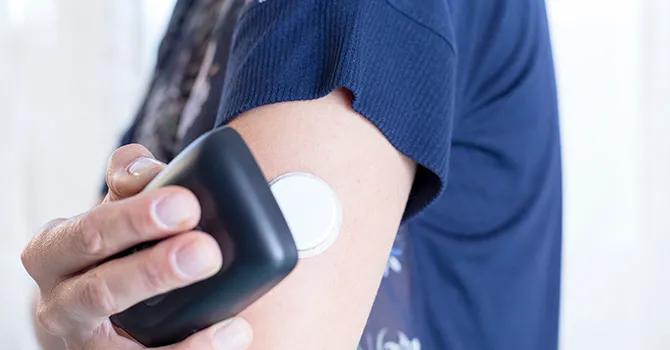Is the online channel the future for the CHC industry? In part 1 of this ecommerce series, we discussed the opportunities and risks of selling medical devices online, while part 2 covered three key paths to becoming an ecommerce champion. Finally, in part 3 we look at a company that’s already leading the way: Abbott
With ecommerce set to become the future of consumer healthcare, companies will face new risks, as well as numerous opportunities. However, there’s already a lot to be learned from CHC companies with a successful online business. In this article, we explore the case of digital pioneer, Abbott, and one of their hottest products, the Freestyle Libre.
Let’s briefly recap on what it takes to compete with the best:
- Generate awareness: Make sure consumers find and buy from you, for example by optimizing product names and descriptions for search engines, and entering paid social media partnerships.
- Stimulate purchases: Welcome consumers to an attractive and user-friendly environment, encourage them to “collect” products (e.g. using a product category generator) and include rankings/bestseller recommendations.
- Drive consumer loyalty: To make sure you grow relationships, not just transactions, complement online subscription models with extra benefits, send repurchase reminders at the right times, and automatize the re-order process.
This all sounds great in theory, but what does “the best” actually look like in practice? And what lessons can be learned from CHC companies that have already made this bold step?
Abbott led the way with its ecommerce strategy!
Healthcare company Abbott enjoyed another year of outstanding performance in 2018 citing innovative product launches as a major contributing factor toward its strong growth. Among these innovations is its flash glucose monitoring device, the FreeStyle Libre 2, which now has (together with the Libre 1) over one million users worldwide.
Can the device’s ongoing success be exclusively drawn back to its mass market appeal? After all, it is profoundly changing the way people with diabetes manage their disease. It can detect trends and track patterns without the use of test strips or lancets, and enables users to monitor their glucose directly via a smartphone app.
However, we also cannot ignore Abbott’s impressive ecommerce strategy and the inroads the company has made into direct patient interaction and distribution. Not only have Abbott mitigated many risks and tapped into the opportunities of the online channel, they’ve pulled on the success levers surrounding awareness, stimulation, and loyalty. Let’s take a closer look at some of the key milestones in Abbott’s ecommerce story.
- Abbott strategically timed the launch of its web shop
Abbott first started selling the FreeStyle Libre exclusively via its own purchase channels, and the company carefully planned the product’s launch in all key EU-5 markets to coincide with the opening of its new web shop. By launching this life-changing device and the new web shop simultaneously, Abbott maximized an early return on investment. In addition, the company circumvented the traditional middle men (typically retail pharmacies), and was able to boost margins as well as build a very promising patient database in the booming flash glucose monitoring space. However, once it obtained reimbursement for its device in most key markets, Abbott failed to maintain its preferred digital distribution channel for these specific patients in France, Italy, Spain, and the UK. But in Germany, even for patients eligible for reimbursement, Abbott’s own platform is still going strong. - Abbott focused on driving consumer loyalty
Abbott secured access to the European markets for its Freestyle Libre when obtaining the CE Mark (Conformité Européenne) in September 2016. Due to limited available clinical evidence of the device’s outcomes, Abbott did not obtain early reimbursement decisions in most markets. Consumers initially had to pay for the device out of pocket. Abbott then had to ensure they continued to engage with and remain loyal to their brand, rather than return to the reimbursed, standard blood glucose monitoring. Therefore, a constant focus on driving customer loyalty has been paramount to Abbott’s continued success. The company checks in on its consumers with regular, targeted email outreach. In addition, users receive around-the-clock customer service, including support through non-traditional channels such as social media. - Abbott ensured a premium “lifestyle” positioning.
Another way Abbott appeals to consumers is by speaking their language: “Diabetes is complex enough. Monitoring your diabetes shouldn’t be” –the FreeStyle Libre’s powerful slogan speaks directly to the patient community. Targeted messages are included in product descriptions, with the words accurate, convenient, and user-friendly prominently featured next to clear product images. Meanwhile, Abbott’s “Live Life to the Fullest” campaign is constantly sparking a conversation with the diabetic population across the globe, including online surveys, social media postings, blog content, and real-life stories, such as this piece on Thorsten Feige, Berlin marathon runner and FreeStyle Libre user. These strong communication efforts toward the target diabetic population have helped the FreeStyle Libre gain its increasing popularity and premium “lifestyle” positioning. - Abbott partnered up with the right social media influencers
Product reviews by diabetes patients and influencers have also been extremely instrumental in generating momentum around the FreeStyle Libre. Right from the beginning, Abbott teamed up with bloggers like Kerri Morrone Sparling and YouTubers like DiabeticDanica, providing them with free product samples and incentives in exchange for sharing their reviews with the online community. The company even hosted an exchange event for influencers, the DX2 in Sydney, so that the Abbott team could better get to know influencers in person. By having bloggers and influencers promote the device, Abbott was able to reach out to its lifestyle segments, with the chance to convince even more potential consumers.
Key takeaways for CHC device manufacturers:
- If your mid- or long-term plan includes applying for reimbursement, be sure to consider the potential forced discontinuation of your ecommerce platform upon receiving reimbursement. This should be factored in when quantifying the opportunity of setting up your own ecommerce platform.
- Important success factors are targeted messaging, customer support and social media presence, and attractive content that speaks to your target consumers.
- Identifying and collaborating with consumer influencers can be a very strong lever for generating awareness, especially in highly engaged groups like the diabetes patient communities.
Outlook: The future consumer healthcare and ecommerce
CHC device companies can no longer rest on their laurels. Increased competition and pressures from neighboring categories mean that the time to act is now. Although many companies are planning to propel themselves into the fast-growing emerging markets in Asia, those without the right ecommerce strategy in place will be in no position to compete.
Industry champions have already started building best practices and are leading the way with increased market penetration and expansion beyond the typical consumer base. And thanks to an increasingly widespread level of consumer comfort, more and more diverse products will start appearing on digital retail platforms.
Read more from our series: Selling CHC Devices Online
Part 1: Selling CHC Devices Online: the Opportunities and Risks
Part 2: Selling CHC Devices Online: Become an Ecommerce Champion








